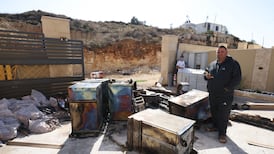Shlomi Katzin attached a GoPro camera to his forehead, slipped on his diving fins and jumped into the waters off the Carmel coast of Israel, eager to go exploring.
On the sandy floor of the Mediterranean Sea, he found a sword. Archaeologists would later determine that it was about 900 years old.
It weighed four pounds, measured about four feet long and originated from the Third Crusade, experts said.
“Oh yes, he was surprised and happy,” said Jacob Sharvit, the director of the marine archaeology unit at the Israel Antiquities Authority. Katzin said he would give the sword to Sharvit’s agency, but he wanted just one thing: a photo with the shell-encrusted weapon.
The recent discovery was welcomed in a country that takes immense pride in its history and has a law requiring that any artifacts found must be returned to the nation. The sword was among several artifacts discovered by Katzin, who declined to be interviewed because he said he did not want the discovery to be about him. He also found stone anchors and pottery fragments that date back hundreds of years. But nothing was more impressive than the sword, which Sharvit described as “extremely rare.”
All of the items were found in the same 1,000-square-foot site. The authority has been aware of the location since June, after a storm shifted the sand. Still, finding artifacts remains elusive because of the movement of the sand.
“It’s normal to find swords in bad condition, but this one was found under the water – and under the water, it was preserved in very good condition,” Sharvit said Monday. “It’s the first time that we found a beautiful sword like this.”
The water off the Carmel coast remains the same temperature year-round, which helped preserve the iron in the sword. Because the iron was oxidizsed, shells and other marine organisms stuck onto it like glue, Sharvit said. The discovery of ancient artifacts has increased as diving has grown in popularity in Israel, he said.
In the Second Crusade, the Muslim forces defeated Western crusaders at Damascus, said Jonathan Phillips, a professor of the history of the Crusades at Royal Holloway, University of London. The sword would have been expensive to make at the time and viewed as a status symbol, Holloway said. It makes sense that it was found in the sea, he said, because many battles were waged near beaches, where Christian soldiers landed and were sometimes attacked by Muslim forces.
“It could have been from a knight who fell in the sea or lost it in a fight at sea,” he said. When Katzin found it, he said he was afraid it would be stolen or buried beneath shifting sand, according to a statement from the authority. The general director of the Israel Antiquities Authority, Eli Escosido, praised Katzin because “every ancient artifact that is found helps us piece together the historical puzzle of the Land of Israel.” Katzin was given a certificate of appreciation for good citizenship.
During the Third Crusade, King Philip Augustus of France, King Richard I (also known as Richard the Lionheart of England), and the holy Roman emperor, Frederick I (also known as Frederick Barbarossa), set out to retake Jerusalem. Saladin, the ruler of an area covering modern Egypt, Syria and Iraq, had conquered it in 1187, said John Cotts, a professor of medieval history at Whitman College in Walla Walla, Washington.
At the time, Pope Gregory VIII tried to inspire Western Christians through "great emotional language" to retake Jerusalem from Muslims, but ultimately the Muslim army maintained control of the city, Cotts said. "Traditionally, the definition of a knight is someone on horseback who engaged in mounted warfare," Cotts said. It is possible that the sword belonged to one of them, and has survived for nine centuries, Sharvit said. After the sword is studied and cleaned, it will be placed in one of the country's museums, Sharvit said. He would not disclose how much it could sell for, he said, because in his opinion, it was "priceless." "Every artifact we find is always a really great feeling," he said. But this one "is very, very special." This article originally appeared in The New York Times.











